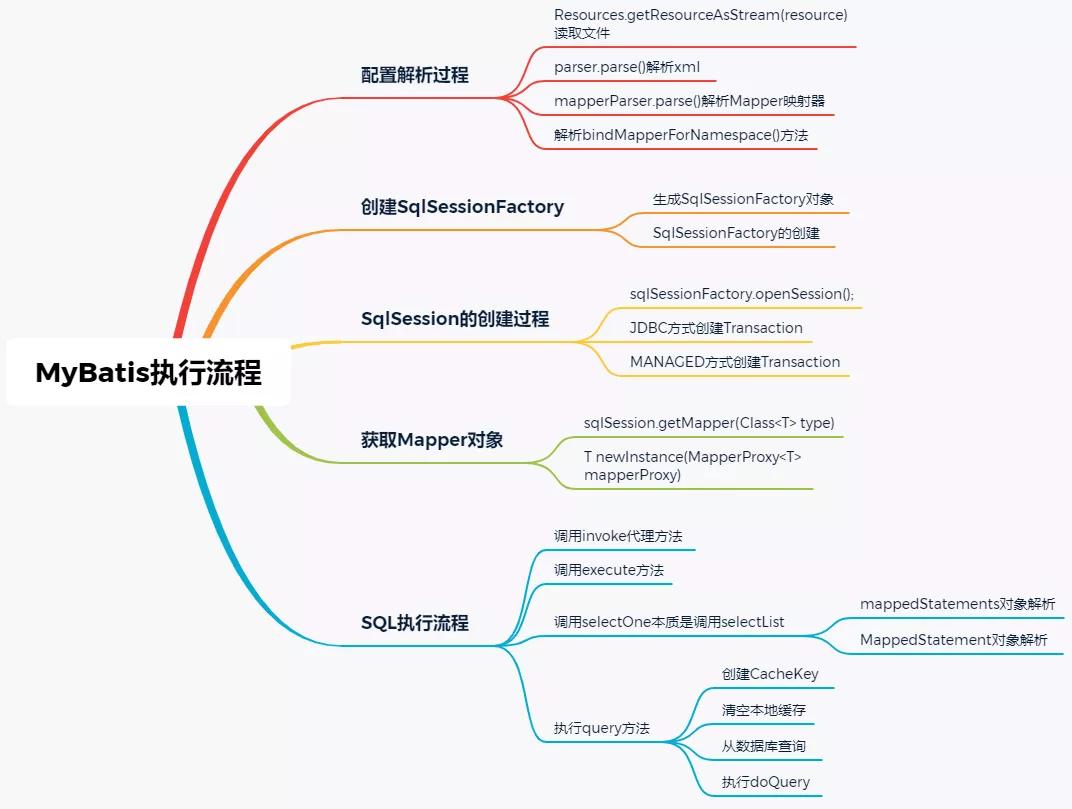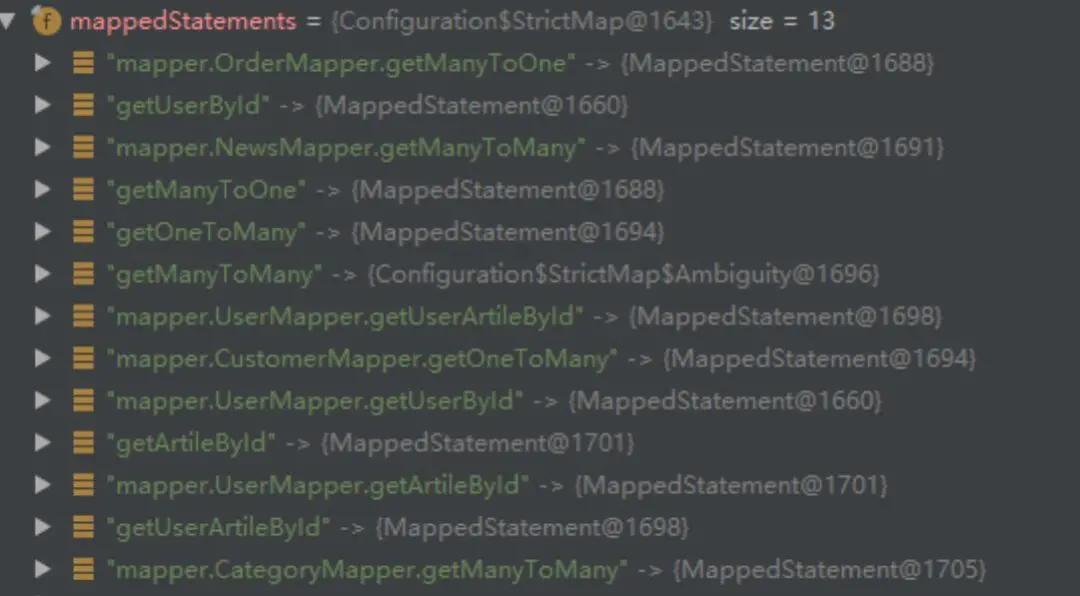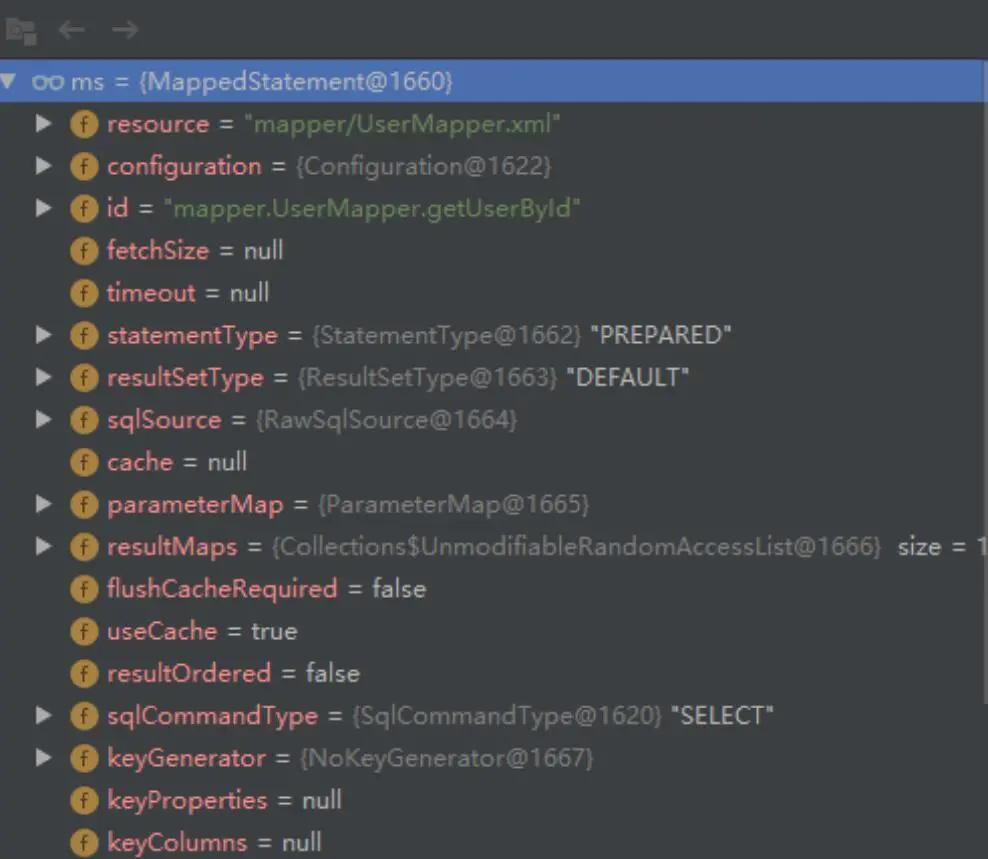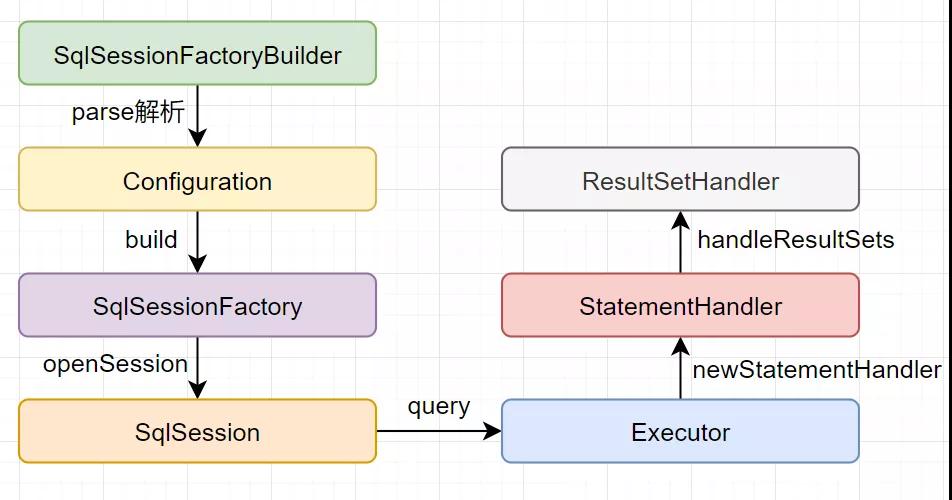随着互联网的发展,越来越多的公司摒弃了Hibernate,而选择拥抱了MyBatis。而且,很多大厂在面试的时候喜欢问MyBatis底层的原理和源码实现。
总之,MyBatis几乎成为了Java开发人员必须深入掌握的框架技术,今天,我们就一起来深入分析MyBatis源码。文章有点长,建议先收藏后慢慢研究。整体三万字左右,全程高能,小伙伴们可慢慢研究。
文章已收录到:
https://github.com/sunshinelyz/technology-binghe
https://gitee.com/binghe001/technology-binghe
本文主要结构如下所示。
MyBatis源码解析
大家应该都知道Mybatis源码也是对Jbdc的再一次封装,不管怎么进行包装,还是会有获取链接、preparedStatement、封装参数、执行这些步骤的。
配置解析过程
- String resource = "mybatis-config.xml";
- //1.读取resources下面的mybatis-config.xml文件
- InputStream inputStream = Resources.getResourceAsStream(resource);
- //2.使用SqlSessionFactoryBuilder创建SqlSessionFactory
- SqlSessionFactory sqlSessionFactory = new SqlSessionFactoryBuilder().build(inputStream);
- //3.通过sqlSessionFactory创建SqlSession
- SqlSession sqlSession = sqlSessionFactory.openSession();
Resources.getResourceAsStream(resource)读取文件
- public static InputStream getResourceAsStream(String resource) throws IOException {
- return getResourceAsStream(null, resource);
- }
- //loader赋值为null
- public static InputStream getResourceAsStream(ClassLoader loader, String resource) throws IOException {
- InputStream in = classLoaderWrapper.getResourceAsStream(resource, loader);
- if (in == null) {
- throw new IOException("Could not find resource " + resource);
- }
- return in;
- }
- //classLoader为null
- public InputStream getResourceAsStream(String resource, ClassLoader classLoader) {
- return getResourceAsStream(resource, getClassLoaders(classLoader));
- }
- //classLoader类加载
- InputStream getResourceAsStream(String resource, ClassLoader[] classLoader) {
- for (ClassLoader cl : classLoader) {
- if (null != cl) {
- //加载指定路径文件流
- InputStream returnValue = cl.getResourceAsStream(resource);
- // now, some class loaders want this leading "/", so we'll add it and try again if we didn't find the resource
- if (null == returnValue) {
- returnValue = cl.getResourceAsStream("/" + resource);
- }
- if (null != returnValue) {
- return returnValue;
- }
- }
- }
- return null;
- }
总结:主要是通过ClassLoader.getResourceAsStream()方法获取指定的classpath路径下的Resource 。
通过SqlSessionFactoryBuilder创建SqlSessionFactory
- //SqlSessionFactoryBuilder是一个建造者模式
- SqlSessionFactory sqlSessionFactory = new SqlSessionFactoryBuilder().build(inputStream);
- public SqlSessionFactory build(InputStream inputStream) {
- return build(inputStream, null, null);
- }
- //XMLConfigBuilder也是建造者模式
- public SqlSessionFactory build(InputStream inputStream, String environment, Properties properties) {
- try {
- XMLConfigBuilder parser = new XMLConfigBuilder(inputStream, environment, properties);
- return build(parser.parse());
- } catch (Exception e) {
- throw ExceptionFactory.wrapException("Error building SqlSession.", e);
- } finally {
- ErrorContext.instance().reset();
- try {
- inputStream.close();
- } catch (IOException e) {
- // Intentionally ignore. Prefer previous error.
- }
- }
- }
- //接下来进入XMLConfigBuilder构造函数
- public XMLConfigBuilder(InputStream inputStream, String environment, Properties props) {
- this(new XPathParser(inputStream, true, props, new XMLMapperEntityResolver()), environment, props);
- }
- //接下来进入this后,初始化Configuration
- private XMLConfigBuilder(XPathParser parser, String environment, Properties props) {
- super(new Configuration());
- ErrorContext.instance().resource("SQL Mapper Configuration");
- this.configuration.setVariables(props);
- this.parsed = false;
- this.environment = environment;
- this.parser = parser;
- }
- //其中parser.parse()负责解析xml,build(configuration)创建SqlSessionFactory
- return build(parser.parse());
parser.parse()解析xml
- public Configuration parse() {
- //判断是否重复解析
- if (parsed) {
- throw new BuilderException("Each XMLConfigBuilder can only be used once.");
- }
- parsed = true;
- //读取配置文件一级节点configuration
- parseConfiguration(parser.evalNode("/configuration"));
- return configuration;
- }
- private void parseConfiguration(XNode root) {
- try {
- //properties 标签,用来配置参数信息,比如最常见的数据库连接信息
- propertiesElement(root.evalNode("properties"));
- Properties settings = settingsAsProperties(root.evalNode("settings"));
- loadCustomVfs(settings);
- loadCustomLogImpl(settings);
- //实体别名两种方式:1.指定单个实体;2.指定包
- typeAliasesElement(root.evalNode("typeAliases"));
- //插件
- pluginElement(root.evalNode("plugins"));
- //用来创建对象(数据库数据映射成java对象时)
- objectFactoryElement(root.evalNode("objectFactory"));
- objectWrapperFactoryElement(root.evalNode("objectWrapperFactory"));
- reflectorFactoryElement(root.evalNode("reflectorFactory"));
- settingsElement(settings);
- // read it after objectFactory and objectWrapperFactory issue #631
- //数据库环境
- environmentsElement(root.evalNode("environments"));
- databaseIdProviderElement(root.evalNode("databaseIdProvider"));
- //数据库类型和Java数据类型的转换
- typeHandlerElement(root.evalNode("typeHandlers"));
- //这个是对数据库增删改查的解析
- mapperElement(root.evalNode("mappers"));
- } catch (Exception e) {
- throw new BuilderException("Error parsing SQL Mapper Configuration. Cause: " + e, e);
- }
- }
总结:parseConfiguration完成的是解析configuration下的标签。
- private void mapperElement(XNode parent) throws Exception {
- if (parent != null) {
- for (XNode child : parent.getChildren()) {
- //解析<package name=""/>
- if ("package".equals(child.getName())) {
- String mapperPackage = child.getStringAttribute("name");
- //包路径存到mapperRegistry中
- configuration.addMappers(mapperPackage);
- } else {
- //解析<mapper url="" class="" resource=""></mapper>
- String resource = child.getStringAttribute("resource");
- String url = child.getStringAttribute("url");
- String mapperClass = child.getStringAttribute("class");
- if (resource != null && url == null && mapperClass == null) {
- ErrorContext.instance().resource(resource);
- //读取Mapper.xml文件
- InputStream inputStream = Resources.getResourceAsStream(resource);
- XMLMapperBuilder mapperParser = new XMLMapperBuilder(inputStream,
- configuration, resource, configuration.getSqlFragments());
- mapperParser.parse();
- } else if (resource == null && url != null && mapperClass == null) {
- ErrorContext.instance().resource(url);
- InputStream inputStream = Resources.getUrlAsStream(url);
- XMLMapperBuilder mapperParser = new XMLMapperBuilder(inputStream,
- configuration, url, configuration.getSqlFragments());
- mapperParser.parse();
- } else if (resource == null && url == null && mapperClass != null) {
- Class<?> mapperInterface = Resources.classForName(mapperClass);
- configuration.addMapper(mapperInterface);
- } else {
- throw new BuilderException("A mapper element may only specify a url, resource or class, but not more than one.");
- }
- }
- }
- }
- }
总结:通过解析configuration.xml文件,获取其中的Environment、Setting,重要的是将下的所有解析出来之后添加到 Configuration,Configuration类似于配置中心,所有的配置信息都在这里。
mapperParser.parse()对 Mapper 映射器的解析
- public void parse() {
- if (!configuration.isResourceLoaded(resource)) {
- //解析所有的子标签
- configurationElement(parser.evalNode("/mapper"));
- configuration.addLoadedResource(resource);
- //把namespace(接口类型)和工厂类绑定起来
- bindMapperForNamespace();
- }
- parsePendingResultMaps();
- parsePendingCacheRefs();
- parsePendingStatements();
- }
- //这里面解析的是Mapper.xml的标签
- private void configurationElement(XNode context) {
- try {
- String namespace = context.getStringAttribute("namespace");
- if (namespace == null || namespace.equals("")) {
- throw new BuilderException("Mapper's namespace cannot be empty");
- }
- builderAssistant.setCurrentNamespace(namespace);
- //对其他命名空间缓存配置的引用
- cacheRefElement(context.evalNode("cache-ref"));
- //对给定命名空间的缓存配置
- cacheElement(context.evalNode("cache"));
- parameterMapElement(context.evalNodes("/mapper/parameterMap"));
- //是最复杂也是最强大的元素,用来描述如何从数据库结果集中来加载对象
- resultMapElements(context.evalNodes("/mapper/resultMap"));
- //可被其他语句引用的可重用语句块
- sqlElement(context.evalNodes("/mapper/sql"));
- //获得MappedStatement对象(增删改查标签)
- buildStatementFromContext(context.evalNodes("select|insert|update|delete"));
- } catch (Exception e) {
- throw new BuilderException("Error parsing Mapper XML. The XML location is '" + resource + "'. Cause: " + e, e);
- }
- }
- //获得MappedStatement对象(增删改查标签)
- private void buildStatementFromContext(List<XNode> list) {
- if (configuration.getDatabaseId() != null) {
- buildStatementFromContext(list, configuration.getDatabaseId());
- }
- buildStatementFromContext(list, null);
- }
- //获得MappedStatement对象(增删改查标签)
- private void buildStatementFromContext(List<XNode> list, String requiredDatabaseId) {
- //循环增删改查标签
- for (XNode context : list) {
- final XMLStatementBuilder statementParser = new XMLStatementBuilder(configuration, builderAssistant, context, requiredDatabaseId);
- try {
- //解析insert/update/select/del中的标签
- statementParser.parseStatementNode();
- } catch (IncompleteElementException e) {
- configuration.addIncompleteStatement(statementParser);
- }
- }
- }
- public void parseStatementNode() {
- //在命名空间中唯一的标识符,可以被用来引用这条语句
- String id = context.getStringAttribute("id");
- //数据库厂商标识
- String databaseId = context.getStringAttribute("databaseId");
- if (!databaseIdMatchesCurrent(id, databaseId, this.requiredDatabaseId)) {
- return;
- }
- String nodeName = context.getNode().getNodeName();
- SqlCommandType sqlCommandType =
- SqlCommandType.valueOf(nodeName.toUpperCase(Locale.ENGLISH));
- boolean isSelect = sqlCommandType == SqlCommandType.SELECT;
- //flushCache和useCache都和二级缓存有关
- //将其设置为true后,只要语句被调用,都会导致本地缓存和二级缓存被清空,默认值:false
- boolean flushCache = context.getBooleanAttribute("flushCache", !isSelect);
- //将其设置为 true 后,将会导致本条语句的结果被二级缓存缓存起来,默认值:对 select 元素为 true
- boolean useCache = context.getBooleanAttribute("useCache", isSelect);
- boolean resultOrdered = context.getBooleanAttribute("resultOrdered", false);
- // Include Fragments before parsing
- XMLIncludeTransformer includeParser = new XMLIncludeTransformer(configuration, builderAssistant);
- includeParser.applyIncludes(context.getNode());
- //会传入这条语句的参数类的完全限定名或别名
- String parameterType = context.getStringAttribute("parameterType");
- Class<?> parameterTypeClass = resolveClass(parameterType);
- String lang = context.getStringAttribute("lang");
- LanguageDriver langDriver = getLanguageDriver(lang);
- // Parse selectKey after includes and remove them.
- processSelectKeyNodes(id, parameterTypeClass, langDriver);
- // Parse the SQL (pre: <selectKey> and <include> were parsed and removed)
- KeyGenerator keyGenerator;
- String keyStatementId = id + SelectKeyGenerator.SELECT_KEY_SUFFIX;
- keyStatementId = builderAssistant.applyCurrentNamespace(keyStatementId, true);
- if (configuration.hasKeyGenerator(keyStatementId)) {
- keyGenerator = configuration.getKeyGenerator(keyStatementId);
- } else {
- keyGenerator = context.getBooleanAttribute("useGeneratedKeys", configuration.isUseGeneratedKeys() && SqlCommandType.INSERT.equals(sqlCommandType)) ? Jdbc3KeyGenerator.INSTANCE : NoKeyGenerator.INSTANCE;
- }
- SqlSource sqlSource = langDriver.createSqlSource(configuration, context, parameterTypeClass);
- StatementType statementType =
- StatementType.valueOf(context.getStringAttribute("statementType",
- StatementType.PREPARED.toString()));
- Integer fetchSize = context.getIntAttribute("fetchSize");
- Integer timeout = context.getIntAttribute("timeout");
- String parameterMap = context.getStringAttribute("parameterMap");
- //从这条语句中返回的期望类型的类的完全限定名或别名
- String resultType = context.getStringAttribute("resultType");
- Class<?> resultTypeClass = resolveClass(resultType);
- //外部resultMap的命名引用
- String resultMap = context.getStringAttribute("resultMap");
- String resultSetType = context.getStringAttribute("resultSetType");
- ResultSetType resultSetTypeEnum = resolveResultSetType(resultSetType);
- String keyProperty = context.getStringAttribute("keyProperty");
- String keyColumn = context.getStringAttribute("keyColumn");
- String resultSets = context.getStringAttribute("resultSets");
- builderAssistant.addMappedStatement(id, sqlSource, statementType, sqlCommandType,
- fetchSize, timeout, parameterMap, parameterTypeClass, resultMap, resultTypeClass,
- resultSetTypeEnum, flushCache, useCache, resultOrdered,
- keyGenerator, keyProperty, keyColumn, databaseId, langDriver, resultSets);
- }
- public MappedStatement addMappedStatement(
- String id,
- SqlSource sqlSource,
- StatementType statementType,
- SqlCommandType sqlCommandType,
- Integer fetchSize,
- Integer timeout,
- String parameterMap,
- Class<?> parameterType,
- String resultMap,
- Class<?> resultType,
- ResultSetType resultSetType,
- boolean flushCache,
- boolean useCache,
- boolean resultOrdered,
- KeyGenerator keyGenerator,
- String keyProperty,
- String keyColumn,
- String databaseId,
- LanguageDriver lang,
- String resultSets) {
- if (unresolvedCacheRef) {
- throw new IncompleteElementException("Cache-ref not yet resolved");
- }
- id = applyCurrentNamespace(id, false);
- boolean isSelect = sqlCommandType == SqlCommandType.SELECT;
- MappedStatement.Builder statementBuilder = new MappedStatement.Builder(configuration,
- id, sqlSource, sqlCommandType)
- .resource(resource)
- .fetchSize(fetchSize)
- .timeout(timeout)
- .statementType(statementType)
- .keyGenerator(keyGenerator)
- .keyProperty(keyProperty)
- .keyColumn(keyColumn)
- .databaseId(databaseId)
- .lang(lang)
- .resultOrdered(resultOrdered)
- .resultSets(resultSets)
- .resultMaps(getStatementResultMaps(resultMap, resultType, id))
- .resultSetType(resultSetType)
- .flushCacheRequired(valueOrDefault(flushCache, !isSelect))
- .useCache(valueOrDefault(useCache, isSelect))
- .cache(currentCache);
- ParameterMap statementParameterMap = getStatementParameterMap(parameterMap,
- parameterType, id);
- if (statementParameterMap != null) {
- statementBuilder.parameterMap(statementParameterMap);
- }
- MappedStatement statement = statementBuilder.build();
- //持有在configuration中
- configuration.addMappedStatement(statement);
- return statement;
- }
- public void addMappedStatement(MappedStatement ms){
- //ms.getId = mapper.UserMapper.getUserById
- //ms = MappedStatement等于每一个增删改查的标签的里的数据
- mappedStatements.put(ms.getId(), ms);
- }
- //最终存放到mappedStatements中,mappedStatements存放的是一个个的增删改查
- protected final Map<String, MappedStatement> mappedStatements = new StrictMap<MappedStatement>("Mapped Statements collection").conflictMessageProducer((savedValue, targetValue) ->
- ". please check " + savedValue.getResource() + " and " + targetValue.getResource());
解析bindMapperForNamespace()方法
把 namespace(接口类型)和工厂类绑定起来。
- private void bindMapperForNamespace() {
- //当前Mapper的命名空间
- String namespace = builderAssistant.getCurrentNamespace();
- if (namespace != null) {
- Class<?> boundType = null;
- try {
- //interface mapper.UserMapper这种
- boundType = Resources.classForName(namespace);
- } catch (ClassNotFoundException e) {
- }
- if (boundType != null) {
- if (!configuration.hasMapper(boundType)) {
- configuration.addLoadedResource("namespace:" + namespace);
- configuration.addMapper(boundType);
- }
- }
- }
- }
- public <T> void addMapper(Class<T> type) {
- mapperRegistry.addMapper(type);
- }
- public <T> void addMapper(Class<T> type) {
- if (type.isInterface()) {
- if (hasMapper(type)) {
- throw new BindingException("Type " + type + " is already known to the MapperRegistry.");
- }
- boolean loadCompleted = false;
- try {
- //接口类型(key)->工厂类
- knownMappers.put(type, new MapperProxyFactory<>(type));
- MapperAnnotationBuilder parser = new MapperAnnotationBuilder(config, type);
- parser.parse();
- loadCompleted = true;
- } finally {
- if (!loadCompleted) {
- knownMappers.remove(type);
- }
- }
- }
- }
生成SqlSessionFactory对象
XMLMapperBuilder.parse()方法,是对 Mapper 映射器的解析里面有两个方法:
(1)configurationElement()解析所有的子标签,最终解析Mapper.xml中的insert/update/delete/select标签的id(全路径)组成key和整个标签和数据连接组成MappedStatement存放到Configuration中的 mappedStatements这个map里面。
(2)bindMapperForNamespace()是把接口类型(interface mapper.UserMapper)和工厂类存到放MapperRegistry中的knownMappers里面。
SqlSessionFactory的创建
- public SqlSessionFactory build(Configuration config) {
- return new DefaultSqlSessionFactory(config);
- }
直接把Configuration当做参数,直接new一个DefaultSqlSessionFactory。
SqlSession会话的创建过程
mybatis操作的时候跟数据库的每一次连接,都需要创建一个会话,我们用openSession()方法来创建。这个会话里面需要包含一个Executor用来执行 SQL。Executor又要指定事务类型和执行器的类型。
创建Transaction(两种方式)
| 属性 | 产生工厂类 | 产生事务 |
|---|---|---|
| JDBC | JbdcTransactionFactory | JdbcTransaction |
| MANAGED | ManagedTransactionFactory | ManagedTransaction |
- 如果配置的是 JDBC,则会使用Connection 对象的 commit()、rollback()、close()管理事务。
- 如果配置成MANAGED,会把事务交给容器来管理,比如 JBOSS,Weblogic。
- SqlSession sqlSession = sqlSessionFactory.openSession();
- public SqlSession openSession() {
- //configuration中有默认赋值protected ExecutorType defaultExecutorType = ExecutorType.SIMPLE
- return openSessionFromDataSource(configuration.getDefaultExecutorType(), null, false);
- }
- <environments default="development">
- <environment id="development">
- <transactionManager type="JDBC"/>
- <dataSource type="POOLED">
- <property name="driver" value="${driver}"/>
- <property name="url" value="${url}"/>
- <property name="username" value="${username}"/>
- <property name="password" value="${password}"/>
- </dataSource>
- </environment>
- </environments>
创建Executor
- //ExecutorType是SIMPLE,一共有三种SIMPLE(SimpleExecutor)、REUSE(ReuseExecutor)、BATCH(BatchExecutor)
- private SqlSession openSessionFromDataSource(ExecutorType execType, TransactionIsolationLevel level, boolean autoCommit) {
- Transaction tx = null;
- try {
- //xml中的development节点
- final Environment environment = configuration.getEnvironment();
- //type配置的是Jbdc所以生成的是JbdcTransactionFactory工厂类
- final TransactionFactory transactionFactory = getTransactionFactoryFromEnvironment(environment);
- //Jdbc生成JbdcTransactionFactory生成JbdcTransaction
- tx = transactionFactory.newTransaction(environment.getDataSource(), level, autoCommit);
- //创建CachingExecutor执行器
- final Executor executor = configuration.newExecutor(tx, execType);
- //创建DefaultSqlSession属性包括 Configuration、Executor对象
- return new DefaultSqlSession(configuration, executor, autoCommit);
- } catch (Exception e) {
- closeTransaction(tx); // may have fetched a connection so lets call
- close()
- throw ExceptionFactory.wrapException("Error opening session. Cause: " + e, e);
- } finally {
- ErrorContext.instance().reset();
- }
- }
获得Mapper对象
- UserMapper userMapper = sqlSession.getMapper(UserMapper.class);
- public T getMapper(Class type) {
- return configuration.getMapper(type, this);
- }
mapperRegistry.getMapper是从MapperRegistry的knownMappers里面取的,knownMappers里面存的是接口类型(interface mapper.UserMapper)和工厂类(MapperProxyFactory)。
- public <T> T getMapper(Class<T> type, SqlSession sqlSession) {
- return mapperRegistry.getMapper(type, sqlSession);
- }
从knownMappers的Map里根据接口类型(interface mapper.UserMapper)取出对应的工厂类。
- public <T> T getMapper(Class<T> type, SqlSession sqlSession) {
- final MapperProxyFactory<T> mapperProxyFactory = (MapperProxyFactory<T>)
- knownMappers.get(type);
- if (mapperProxyFactory == null) {
- throw new BindingException("Type " + type + " is not known to the MapperRegistry.");
- }
- try {
- return mapperProxyFactory.newInstance(sqlSession);
- } catch (Exception e) {
- throw new BindingException("Error getting mapper instance. Cause: " + e, e);
- }
- }
- public T newInstance(SqlSession sqlSession) {
- final MapperProxy<T> mapperProxy = new MapperProxy<>(sqlSession, mapperInterface, methodCache);
- return newInstance(mapperProxy);
- }
这里通过JDK动态代理返回代理对象MapperProxy(org.apache.ibatis.binding.MapperProxy@6b2ea799)。
- protected T newInstance(MapperProxy<T> mapperProxy) {
- //mapperInterface是interface mapper.UserMapper
- return (T) Proxy.newProxyInstance(mapperInterface.getClassLoader(), new
- Class[] { mapperInterface }, mapperProxy);
- }
- UserMapper userMapper = sqlSession.getMapper(UserMapper.class);
执行SQL
- User user = userMapper.getUserById(1);
调用invoke代理方法
由于所有的 Mapper 都是 MapperProxy 代理对象,所以任意的方法都是执行MapperProxy 的invoke()方法。
- public Object invoke(Object proxy, Method method, Object[] args) throws Throwable {
- try {
- //判断是否需要去执行SQL还是直接执行方法
- if (Object.class.equals(method.getDeclaringClass())) {
- return method.invoke(this, args);
- //这里判断的是接口中的默认方法Default等
- } else if (isDefaultMethod(method)) {
- return invokeDefaultMethod(proxy, method, args);
- }
- } catch (Throwable t) {
- throw ExceptionUtil.unwrapThrowable(t);
- }
- //获取缓存,保存了方法签名和接口方法的关系
- final MapperMethod mapperMethod = cachedMapperMethod(method);
- return mapperMethod.execute(sqlSession, args);
- }
调用execute方法
这里使用的例子用的是查询所以走的是else分支语句。
- public Object execute(SqlSession sqlSession, Object[] args) {
- Object result;
- //根据命令类型走不行的操作command.getType()是select
- switch (command.getType()) {
- case INSERT: {
- Object param = method.convertArgsToSqlCommandParam(args);
- result = rowCountResult(sqlSession.insert(command.getName(), param));
- break;
- }
- case UPDATE: {
- Object param = method.convertArgsToSqlCommandParam(args);
- result = rowCountResult(sqlSession.update(command.getName(), param));
- break;
- }
- case DELETE: {
- Object param = method.convertArgsToSqlCommandParam(args);
- result = rowCountResult(sqlSession.delete(command.getName(), param));
- break;
- }
- case SELECT:
- if (method.returnsVoid() && method.hasResultHandler()) {
- executeWithResultHandler(sqlSession, args);
- result = null;
- } else if (method.returnsMany()) {
- result = executeForMany(sqlSession, args);
- } else if (method.returnsMap()) {
- result = executeForMap(sqlSession, args);
- } else if (method.returnsCursor()) {
- result = executeForCursor(sqlSession, args);
- } else {
- //将参数转换为SQL的参数
- Object param = method.convertArgsToSqlCommandParam(args);
- result = sqlSession.selectOne(command.getName(), param);
- if (method.returnsOptional()
- && (result == null ||
- !method.getReturnType().equals(result.getClass()))) {
- result = Optional.ofNullable(result);
- }
- }
- break;
- case FLUSH:
- result = sqlSession.flushStatements();
- break;
- default:
- throw new BindingException("Unknown execution method for: " + command.getName());
- }
- if (result == null && method.getReturnType().isPrimitive() && !method.returnsVoid()) {
- throw new BindingException("Mapper method '" + command.getName() + " attempted to return null from a method with a primitive return type (" + method.getReturnType() + ").");
- }
- return result;
- }
调用selectOne其实是selectList
selectOne查询一个和查询多个其实是一样的。
- public <T> T selectOne(String statement, Object parameter) {
- // Popular vote was to return null on 0 results and throw exception on too many.
- List<T> list = this.selectList(statement, parameter);
- if (list.size() == 1) {
- return list.get(0);
- } else if (list.size() > 1) {
- throw new TooManyResultsException("Expected one result (or null) to be returned by selectOne(), but found: " + list.size());
- } else {
- return null;
- }
- }
- public <E> List<E> selectList(String statement, Object parameter, RowBounds rowBounds) {
- try {
- //从Configuration里的mappedStatements里根据key(id的全路径)获取MappedStatement 对象
- MappedStatement ms = configuration.getMappedStatement(statement);
- return executor.query(ms, wrapCollection(parameter), rowBounds, Executor.NO_RESULT_HANDLER);
- } catch (Exception e) {
- throw ExceptionFactory.wrapException("Error querying database. Cause: " + e, e);
- } finally {
- ErrorContext.instance().reset();
- }
- }
mappedStatements对象如图
MappedStatement对象如图
执行query方法
创建CacheKey
从 BoundSql 中获取SQL信息,创建 CacheKey。这个CacheKey就是缓存的Key。
- public <E> List<E> query(MappedStatement ms, Object parameterObject, RowBounds rowBounds, ResultHandler resultHandler) throws SQLException {
- //创建缓存Key
- BoundSql boundSql = ms.getBoundSql(parameterObject);
- //key = -575461213:-771016147:mapper.UserMapper.getUserById:0:2147483647:select * from test_user where id = ?:1:development
- CacheKey key = createCacheKey(ms, parameterObject, rowBounds, boundSql);
- return query(ms, parameterObject, rowBounds, resultHandler, key, boundSql);
- }
- public <E> List<E> query(MappedStatement ms, Object parameterObject, RowBounds rowBounds, ResultHandler resultHandler, CacheKey key, BoundSql boundSql) throws SQLException {
- Cache cache = ms.getCache();
- if (cache != null) {
- flushCacheIfRequired(ms);
- if (ms.isUseCache() && resultHandler == null) {
- ensureNoOutParams(ms, boundSql);
- @SuppressWarnings("unchecked")
- List<E> list = (List<E>) tcm.getObject(cache, key);
- if (list == null) {
- list = delegate.query(ms, parameterObject, rowBounds, resultHandler, key, boundSql);
- tcm.putObject(cache, key, list); // issue #578 and #116
- }
- return list;
- }
- }
- return delegate.query(ms, parameterObject, rowBounds, resultHandler, key, boundSql);
- }
清空本地缓存
- public <E> List<E> query(MappedStatement ms, Object parameter, RowBounds rowBounds, ResultHandler resultHandler, CacheKey key, BoundSql boundSql) throws SQLException {
- ErrorContext.instance().resource(ms.getResource()).activity("executing a query").object(ms.getId());
- if (closed) {
- throw new ExecutorException("Executor was closed.");
- }
- //queryStack 用于记录查询栈,防止递归查询重复处理缓存
- //flushCache=true 的时候,会先清理本地缓存(一级缓存)
- if (queryStack == 0 && ms.isFlushCacheRequired()) {
- //清空本地缓存
- clearLocalCache();
- }
- List<E> list;
- try {
- queryStack++;
- list = resultHandler == null ? (List<E>) localCache.getObject(key) : null;
- if (list != null) {
- handleLocallyCachedOutputParameters(ms, key, parameter, boundSql);
- } else {
- //如果没有缓存,会从数据库查询:queryFromDatabase()
- list = queryFromDatabase(ms, parameter, rowBounds, resultHandler, key, boundSql);
- }
- } finally {
- queryStack--;
- }
- if (queryStack == 0) {
- for (DeferredLoad deferredLoad : deferredLoads) {
- deferredLoad.load();
- }
- // issue #601
- deferredLoads.clear();
- //如果 LocalCacheScope == STATEMENT,会清理本地缓存
- if (configuration.getLocalCacheScope() == LocalCacheScope.STATEMENT) {
- // issue #482
- clearLocalCache();
- }
- }
- return list;
- }
从数据库查询
- private <E> List<E> queryFromDatabase(MappedStatement ms, Object parameter, RowBounds rowBounds, ResultHandler resultHandler, CacheKey key, BoundSql boundSql) throws SQLException {
- List<E> list;
- //先在缓存用占位符占位
- localCache.putObject(key, EXECUTION_PLACEHOLDER);
- try {
- //执行Executor 的 doQuery(),默认是SimpleExecutor
- list = doQuery(ms, parameter, rowBounds, resultHandler, boundSql);
- } finally {
- //执行查询后,移除占位符
- localCache.removeObject(key);
- }
- //从新放入数据
- localCache.putObject(key, list);
- if (ms.getStatementType() == StatementType.CALLABLE) {
- localOutputParameterCache.putObject(key, parameter);
- }
- return list;
- }
执行doQuery
- public <E> List<E> doQuery(MappedStatement ms, Object parameter, RowBounds rowBounds, ResultHandler resultHandler, BoundSql boundSql) throws SQLException {
- Statement stmt = null;
- try {
- Configuration configuration = ms.getConfiguration();
- StatementHandler handler = configuration.newStatementHandler(wrapper, ms, parameter, rowBounds, resultHandler, boundSql);
- stmt = prepareStatement(handler, ms.getStatementLog());
- return handler.query(stmt, resultHandler);
- } finally {
- closeStatement(stmt);
- }
- }
源码总结
总体上来说,MyBatis的源码还是比较简单的,只要大家踏下心来,花个两三天仔细研究下,基本上都能弄明白源码的主体脉络。为了方便小伙伴们理解,冰河为大家整理了一个MyBatis整体执行的流程图。
好了,今天就到这儿吧,我是冰河,我们下期见~~。
本文转载自微信公众号「冰河技术」,可以通过以下二维码关注。转载本文请联系冰河技术公众号。










































